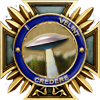In a quest for Cold War military superiority, the United States detonated more than 1,000 nuclear weapons. Government researchers blew up many of the bombs on the ground and others in ocean atolls. Yet as threats moved into space and concerns about fallout increased - material that's sucked into a blast can become radioactive - the US exploded 210 of the terrifying devices high in the atmosphere.
Films of the blasts, made from 1945 through 1962, were analysed then locked away in high-security vaults. It's likely no one has seen the footage for decades. But now, after more than 65 years of collecting dust, the US has declassified 750 of the high-speed films for the first time - and released dozens of digital scans on YouTube.
We first heard about the movies from writer Sarah Zhang on Twitter.
A team of Lawrence Livermore National Laboratory (LLNL) scientists led the rescue of thousands of the films over the past five years. They're made of nitrate cellulose, which releases a vinegar smell as they degrade, according to a LLNL release.
"This is it. We got to this project just in time," Greg Spriggs, a nuclear weapons physicist at LLNL, said in a video about the digitisation effort.
"We know that these films are on the brink of decomposing, to the point where they will become useless." The project isn't just about shedding daylight on the advent of the nuclear age: Spriggs said it's also about getting lost data about high-altitude test blasts, which are prohibited around the world yet still poorly understood. (However, the US has yet to officially agree to the ban.)
"We don't have any experimental data for modern weapons in the atmosphere. The only data we have are the old tests, so it gets a little bit more complicated," he said. The data may help researchers better understand the effects of nuclear explosions and manage thousands of the weapons currently in the US stockpile. "We found out that most of the data published was wrong," Spriggs said. "We decided we need to re-scan and reanalyse all of the films." About 10,000 of the movies were made, and at speeds of thousands of frames per second to slow down fast-expanding explosions.
However, it took LLNL roughly five years to locate about 6,500 of them, and scan 4,200 of those. Spriggs said the team analysed somewhere between 400 and 500 of the films. Jim Moye, a rare films expert and veteran of the movie industry, helped scan and archive the footage. "It is going to be gone at some point, and we don't have forever to do this," Moye said in the video. The project is important to "help certify that the ageing US nuclear deterrent remains safe, secure and effective," LLNL wrote in its YouTube video description.
"We're discovering new things about these detonations that have never been seen before," Spriggs said.













